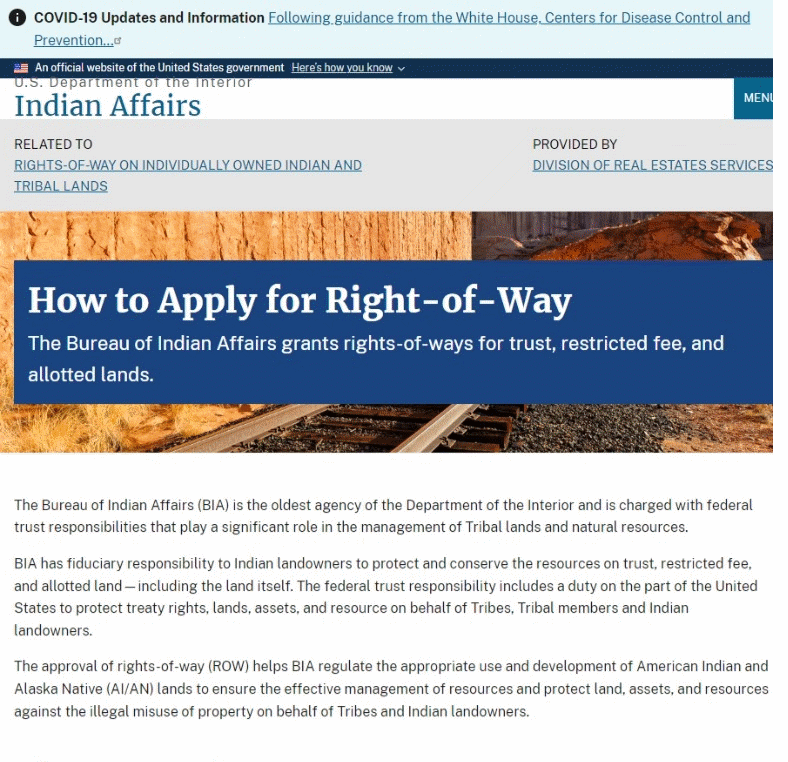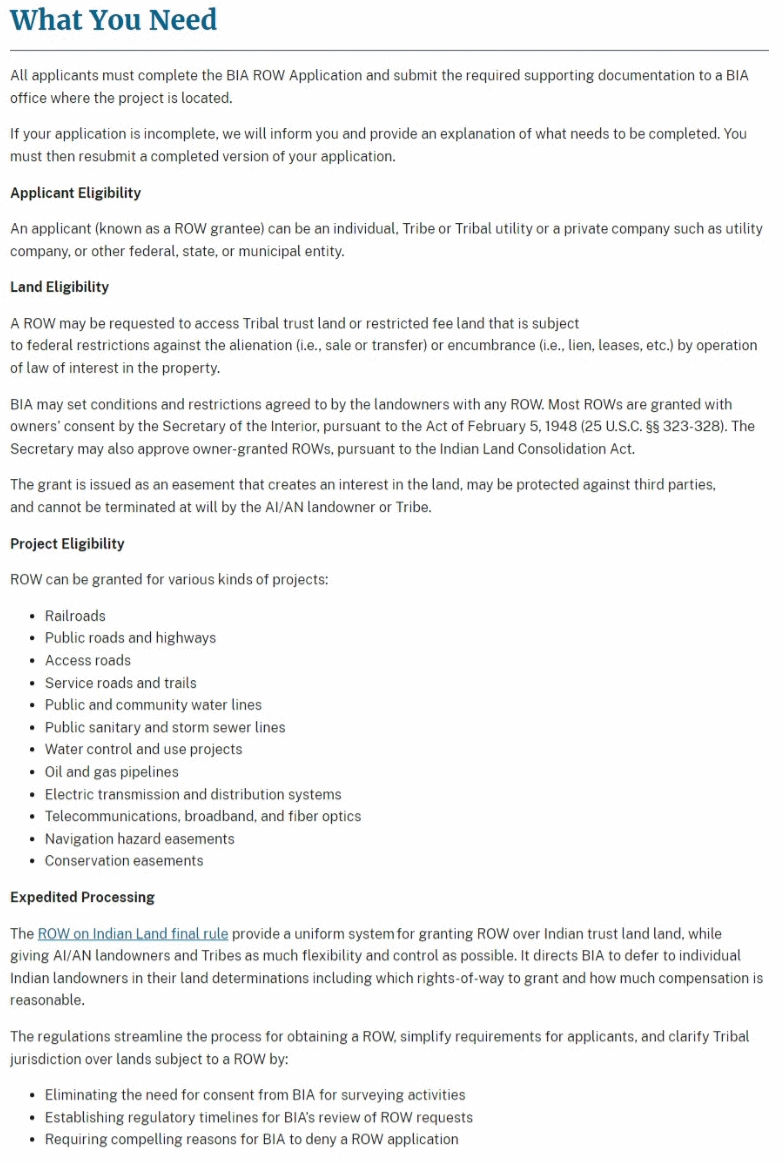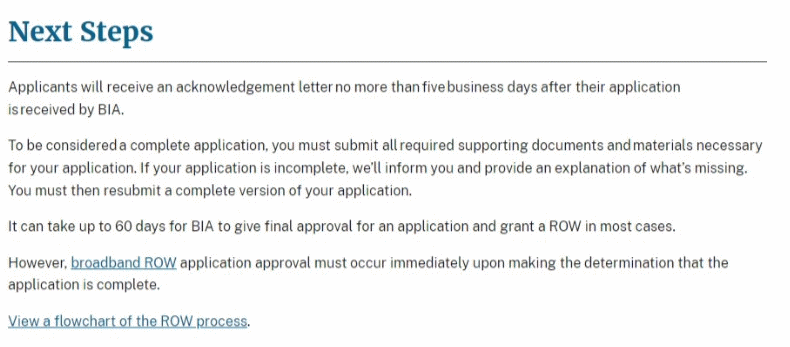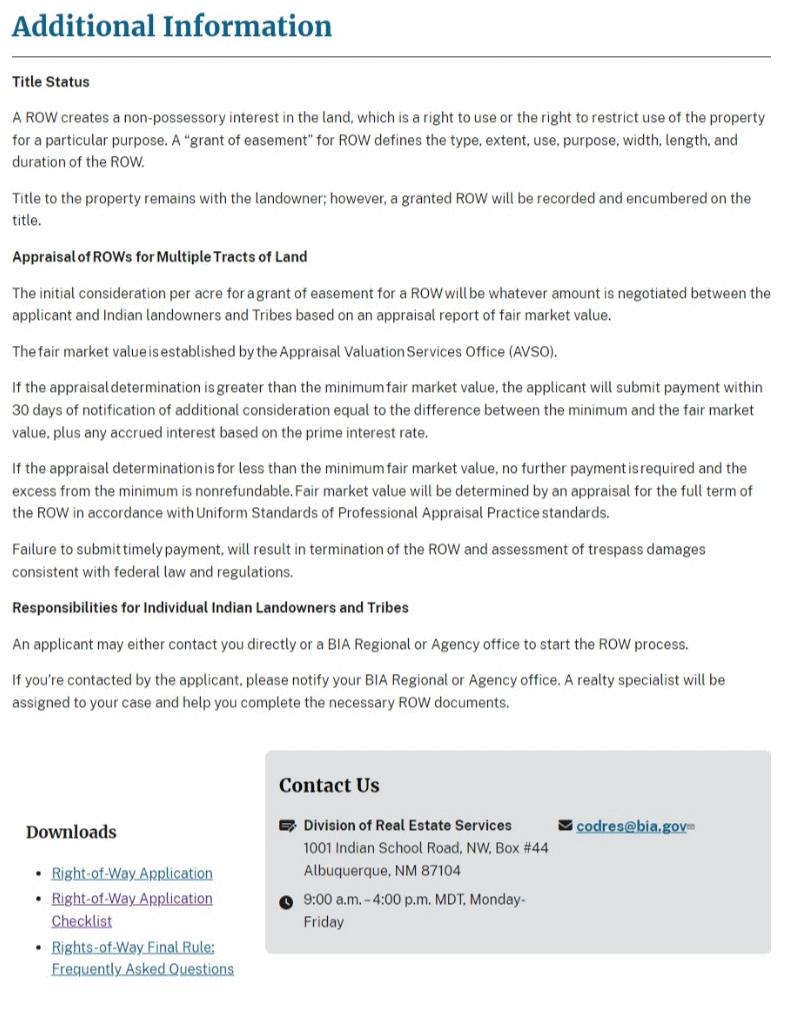Iafr001137__ssa (1076-0181)_cy2023
IAFR001137__SSA (1076-0181)_CY2023.docx
25 CFR 169, Rights-of-Way on Indian Land
OMB: 1076-0181
Supporting Statement A
Rights-of-Way on Indian Land
OMB Control Number 1076-0181
Terms of Clearance: None.
General Instructions
A completed Supporting Statement A must accompany each request for approval of a collection of information. The Supporting Statement must be prepared in the format described below, and must contain the information specified below. If an item is not applicable, provide a brief explanation. When the question “Does this ICR contain surveys, censuses, or employ statistical methods?” is checked "Yes," then a Supporting Statement B must be completed. OMB reserves the right to require the submission of additional information with respect to any request for approval.
Specific Instructions
Justification
1. Explain the circumstances that make the collection of information necessary. Identify any legal or administrative requirements that necessitate the collection.
This information collection is necessary for the Bureau of Indian Affairs (BIA) to authorize rights-of-way to cross land held in trust or restricted status on behalf of individual Indians and tribes, for a specific purpose, including but not limited to building and operating a line or road. The statutory authority for this program is at 25 U.S.C. 323-328. The regulations at 25 CFR 169 implement the statutory authority.
Terms of Clearance (ICR Reference No: 201908-1076-001)
BIA has updated online guidance in order to alleviate public burdens associated with BIA’s process and procedures for right-of-way (ROW) actions. The following images outline BIA’s updated guidance.
-
BIA Website link:






2. Indicate how, by whom, and for what purpose the information is to be used. Except for a new collection, indicate the actual use the agency has made of the information received from the current collection. Be specific. If this collection is a form or a questionnaire, every question needs to be justified.
BIA uses the information it collects to determine whether or not to grant a right-of-way, the value of the right-of-way, the appropriate compensation due to landowners, the amount of administrative fees that must be levied, and the penalties, if any, that should be assessed for violations of the right-of-way provisions.
The following chart shows these information collection requirements and how BIA uses the information.
CFR Cite |
Information Collection Requirement |
BIA Use of Information |
169.102, 169.204, 169.207, 169.210 |
Submit the right-of-way application form, as well as amendment, assignment, or mortgage information, when necessary. Application must identify: (1) The applicant; (2) The tract(s) or parcel(s) affected by the right-of-way; (3) The general location of the right-of-way; (4) The purpose of the right-of-way and whether it is a new right-of-way or a renewal, amendment, assignment, or mortgage of a right-of-way; (5) The duration of the right-of-way: and (6) The ownership of permanent improvements associated with the right-of-way and the responsibility for constructing, operating, maintaining, and managing permanent improvements.
|
BIA reviews the information to identify the applicant, the location, purpose, and duration of the right-of-way, and the ownership and responsibility for any permanent improvements associated with the right-of-way. |
(1) An accurate legal description of the right-of-way, its boundaries, and parcels associated with the right-of-way;
|
BIA uses this information to determine the location of the right-of-way. |
|
(2) A map of definite location of the right-of-way and existing facilities adjacent to the proposed project, signed by a professional surveyor or engineer (this requirement does not apply to easements covering the entire tract of land);
|
BIA uses this information to identify the location of the right-of-way in relation to existing facilities. |
|
(3) A bond meeting the requirements of § 169.103;
|
BIA uses this information to ensure there are sufficient resources to address any damage resulting from the right-of-way. |
|
(4) Record of consent of tribal landowners and individual Indian landowners for the right-of-way meeting the requirements of § 169.107;
|
BIA uses this information to ensure the landowners authorize the right-of-way. |
|
(5) If applicable, a valuation meeting the requirements of § 169.114;
|
BIA uses this information to ensure the landowner receives fair market value, where appropriate. |
|
(6) If the applicant is a corporation, limited liability company, partnership, joint venture, or other legal entity, except a tribal entity, information such as organizational documents, certificates, filing records, and resolutions, that demonstrates that: (i) The representative has authority to execute the application; (ii) The right-of-way will be enforceable against the applicant; and (iii) The legal entity is in good standing and authorized to conduct business in the jurisdiction where the land is located |
BIA uses this information to determine if the applicant is authorized and in good standing. |
|
(7) Environmental and archeological reports, surveys, and site assessments, as needed to facilitate compliance with applicable Federal and tribal environmental and land use requirements.
|
BIA uses this information to determine if a right-of-way should be granted in compliance with applicable laws. |
|
169.404 |
Provide notice of curing violation or adequate proof of payment |
BIA uses this information to determine whether to pursue further enforcement action. |
169.412 |
Respond to notice of trespass |
BIA uses this information to determine whether to pursue further enforcement action. |
169.56
|
File copy of service line agreement and plot with BIA. |
BIA uses this information to ensure authorization for the service line. |
169.007 |
File past assignment with BIA. |
BIA uses this information to keep track of who the current holder of a right-of-way grant is. |
3. Describe whether, and to what extent, the collection of information involves the use of automated, electronic, mechanical, or other technological collection techniques or other forms of information technology, e.g., permitting electronic submission of responses, and the basis for the decision for adopting this means of collection. Also describe any consideration of using information technology to reduce burden and specifically how this collection meets GPEA requirements.
To the extent respondents provide information in written form, rather than orally, BIA accepts the information via fax or e-mail to reduce burden on respondents.
4. Describe efforts to identify duplication. Show specifically why any similar information already available cannot be used or modified for use for the purposes described in Item 2 above.
There is a form, SF 299, for rights-of-way across Federal land; however, we cannot use it here because that form addresses Federal land, rather than Indian land, and does not include all the information necessary for rights-of-way on Indian land. Most significantly, the SF 299 does not include information on the landowner, because the Federal Government is the landowner, whereas information on the beneficial landowners is necessary for Indian land to ensure that the requisite consent is obtained from landowners. This information collected under 25 CFR Part 169 is not duplicated in any other data collection.
5. If the collection of information impacts small businesses or other small entities, describe any methods used to minimize burden.
BIA consulted with the tribes and through various tribal-member non-governmental organizations to determine what information collection was necessary to ensure the fair and equitable administration of rights-of-way on Indian land. Through this consultation, the information collection burden has been minimized and is reflected in the regulations.
6. Describe the consequence to Federal program or policy activities if the collection is not conducted or is conducted less frequently, as well as any technical or legal obstacles to reducing burden.
The information collection burden cannot be reduced any further without the integrity of the rights-of-way program being jeopardized. Information is collected, as needed, when an applicant seeks permission to cross trust or restricted land. If the collection is not conducted, or is conducted less frequently, the BIA will not be able to properly administer and monitor rights-of-way and trespass on Indian land.
7. Explain any special circumstances that would cause an information collection to be conducted in a manner:
* requiring respondents to report information to the agency more often than quarterly;
* requiring respondents to prepare a written response to a collection of information in fewer than 30 days after receipt of it;
* requiring respondents to submit more than an original and two copies of any document;
* requiring respondents to retain records, other than health, medical, government contract, grant-in-aid, or tax records, for more than three years;
* in connection with a statistical survey that is not designed to produce valid and reliable results that can be generalized to the universe of study;
* requiring the use of a statistical data classification that has not been reviewed and approved by OMB;
* that includes a pledge of confidentiality that is not supported by authority established in statute or regulation, that is not supported by disclosure and data security policies that are consistent with the pledge, or which unnecessarily impedes sharing of data with other agencies for compatible confidential use; or
* requiring respondents to submit proprietary trade secrets, or other confidential information, unless the agency can demonstrate that it has instituted procedures to protect the information's confidentiality to the extent permitted by law.
There are circumstances that require exceptions to 5 CFR 1320.5(d)(2).
The regulations in §169.113 require that compensation for the rights-of-way, were not a one-time, lump-sum payment, be paid by the dates specified in the right-of-way grant. While each right-of-way grant is specific and the regulations do not specify otherwise, there is a potential for responding to a notice of delinquency in less than 30 days.
In §169.404, the grantee is given 10 business days from the receipt of the notice of violation to respond. This is an exception to the 30-day rule because time is of the essence in correcting violations of right-of-way grants. A 30-day period to respond would endanger the integrity of the grant instrument and possibly do irreparable damage to the corpus of the trust resource.
8. If applicable, provide a copy and identify the date and page number of publication in the Federal Register of the agency's notice, required by 5 CFR 1320.8(d), soliciting comments on the information collection prior to submission to OMB. Summarize public comments received in response to that notice and in response to the PRA statement associated with the collection over the past three years, and describe actions taken by the agency in response to these comments. Specifically address comments received on cost and hour burden.
A Federal Register notice with a 60-day public comment period soliciting comments on this collection of information was published on September 20, 2022 (87 FR 43889). No comments were received.
Describe efforts to consult with persons outside the agency to obtain their views on the availability of data, frequency of collection, the clarity of instructions and recordkeeping, disclosure, or reporting format (if any), and on the data elements to be recorded, disclosed, or reported.
Consultation with representatives of those from whom information is to be obtained or those who must compile records should occur at least once every three years — even if the collection of information activity is the same as in prior periods. There may be circumstances that may preclude consultation in a specific situation. These circumstances should be explained.
The BIA requested feedback from three Tribal users and received the following feedback.
Users indicated the process is standardized and well understood by Tribal stakeholders.
Users indicated the website information is clear and accessible. See https://www.bia.gov/service/rights-of-way-individually-owned-indian-and-tribal-lands/apply-right-of-way.
9. Explain any decision to provide any payment or gift to respondents, other than remuneration of contractors or grantees.
No payments or gifts are provided to respondents.
10. Describe any assurance of confidentiality provided to respondents and the basis for the assurance in statute, regulation, or agency policy.
There is no assurance of confidentiality provided to respondents concerning this information collection.
11. Provide additional justification for any questions of a sensitive nature, such as sexual behavior and attitudes, religious beliefs, and other matters that are commonly considered private. This justification should include the reasons why the agency considers the questions necessary, the specific uses to be made of the information, the explanation to be given to persons from whom the information is requested, and any steps to be taken to obtain their consent.
We are not requesting information of a sensitive nature.
12. Provide estimates of the hour burden of the collection of information. The statement should:
* Indicate the number of respondents, frequency of response, annual hour burden, and an explanation of how the burden was estimated. Unless directed to do so, agencies should not conduct special surveys to obtain information on which to base hour burden estimates. Consultation with a sample (fewer than 10) of potential respondents is desirable. If the hour burden on respondents is expected to vary widely because of differences in activity, size, or complexity, show the range of estimated hour burden, and explain the reasons for the variance. Generally, estimates should not include burden hours for customary and usual business practices.
* If this request for approval covers more than one form, provide separate hour burden estimates for each form and aggregate the hour burdens.
* Provide estimates of annualized cost to respondents for the hour burdens for collections of information, identifying and using appropriate wage rate categories. The cost of contracting out or paying outside parties for information collection activities should not be included here.
There are approximately 3,200 respondents and responses to this information collection with a total hourly burden of 39,050. The total number of responses and annual burden hours is shown in the table below. The total salary burden for the collection is $1,658,844.
Salary was estimated using the Bureau of Labor Statistics, EMPLOYER COSTS FOR EMPLOYEE COMPENSATION – December 2022, USDL-23-0488, Table 1. Employer Costs for Employee Compensation by ownership, for civilians totaling $42.48 per hour for all tribal workers. The employee cost for compensation was obtained from the Bureau of Labor Statistics at the following web address: https://www.bls.gov/news.release/pdf/ecec.pdf
IC § |
Description of Requirement |
Respondents |
Responses
|
Burden hours per response |
Annual burden hours |
Salary cost $36.61 |
169.102, 169.204, 169.207, 169.210 |
Submit application for right-of-way, amendment, assignment or mortgage, and supporting documents. |
1,100 |
1,100 |
35 |
38,500 |
$1,635,480 |
169.404 |
Respond to notice of violation. |
50 |
50 |
0.5 |
25 |
$1,062 |
169.413 |
Respond to notice of trespass. |
50 |
50 |
0.5 |
25 |
$1,062 |
169.56 |
File service line agreement with BIA. |
1,000 |
1,000 |
0.25 |
250 |
$10,620 |
169.007 |
File past assignments with BIA. |
1,000 |
1,000 |
0.25 |
250 |
$10,620 |
Total |
|
3,200 |
3,200 |
|
39,050 |
$1,658,844 |
13. Provide an estimate of the total annual non-hour cost burden to respondents or recordkeepers resulting from the collection of information. (Do not include the cost of any hour burden already reflected in item 12.)
* The cost estimate should be split into two components: (a) a total capital and start-up cost component (annualized over its expected useful life) and (b) a total operation and maintenance and purchase of services component. The estimates should take into account costs associated with generating, maintaining, and disclosing or providing the information (including filing fees paid for form processing). Include descriptions of methods used to estimate major cost factors including system and technology acquisition, expected useful life of capital equipment, the discount rate(s), and the time period over which costs will be incurred. Capital and start-up costs include, among other items, preparations for collecting information such as purchasing computers and software; monitoring, sampling, drilling and testing equipment; and record storage facilities.
* If cost estimates are expected to vary widely, agencies should present ranges of cost burdens and explain the reasons for the variance. The cost of purchasing or contracting out information collection services should be a part of this cost burden estimate. In developing cost burden estimates, agencies may consult with a sample of respondents (fewer than 10), utilize the 60-day pre-OMB submission public comment process and use existing economic or regulatory impact analysis associated with the rulemaking containing the information collection, as appropriate.
* Generally, estimates should not include purchases of equipment or services, or portions thereof, made: (1) prior to October 1, 1995, (2) to achieve regulatory compliance with requirements not associated with the information collection, (3) for reasons other than to provide information or keep records for the government, or (4) as part of customary and usual business or private practices.
BIA estimates an annual non-hour cost burden of $1,281,770.
There is a non-hour cost burden associated with this information collection to obtain a legal description and a survey signed by a professional engineer or surveyor. Together, these cost approximately $1,165 for each of the 1,100 right-of-way requests each year.
BIA’s calculation incudes a 1.4% annual BLS wage adjustment
$1,165 est. cost for professional services x 1,100 est. responses = $1,281,770.
14. Provide estimates of annualized cost to the Federal government. Also, provide a description of the method used to estimate cost, which should include quantification of hours, operational expenses (such as equipment, overhead, printing, and support staff), and any other expense that would not have been incurred without this collection of information.
The annualized cost to the Federal Government for this information collection is $66,958.
An average salary of $40.58 per hour, including a 1.6 benefits multiplier, was used for support staff. See, 2023 General Schedule (Base) – Hourly Rate (GS 7, Step 5) at https://www.opm.gov/policy-data-oversight/pay-leave/salaries-wages/salary-tables/23Tables/html/RUS_h.aspx.
IC § |
Description of Requirement |
Responses
|
Hours per response |
Annual hours |
Salary cost |
169.102, 169.204, 169.207, 169.210 |
Submit application for right-of-way, amendment, assignment or mortgage, and supporting documents. |
1,100 |
1 |
1,100 |
$44,638 |
169.404 |
Respond to notice of violation. |
50 |
.5 |
25 |
$1,015 |
169.413 |
Respond to notice of trespass. |
50 |
.5 |
25 |
$1,015 |
169.56 |
File service line agreement with BIA. |
1,000 |
.25 |
250 |
$10,145 |
169.007 |
File past assignments with BIA. |
1,000 |
.25 |
250 |
$10,145 |
Total |
|
3,200 |
|
1,650 |
15. Explain the reasons for any program changes or adjustments in hour or cost burden.
Updates were made to the Bureau of Labor Statistics (BLS) and Office of Personnel Management (OPM) compensation data contained in Sections 12 and 14.
16. For collections of information whose results will be published, outline plans for tabulation and publication. Address any complex analytical techniques that will be used. Provide the time schedule for the entire project, including beginning and ending dates of the collection of information, completion of report, publication dates, and other actions.
There is no intention to publish this information.
17. If seeking approval to not display the expiration date for OMB approval of the information collection, explain the reasons that display would be inappropriate.
We will display the OMB Control Number and the expiration date on the form.
18. Explain each exception to the topics of the certification statement identified in "Certification for Paperwork Reduction Act Submissions."
There are no exceptions.
| File Type | application/vnd.openxmlformats-officedocument.wordprocessingml.document |
| Author | djbieniewicz |
| File Modified | 0000-00-00 |
| File Created | 2023-07-29 |
© 2026 OMB.report | Privacy Policy